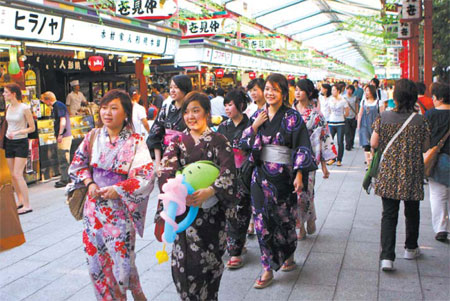Tokyo's charm lies in many layers, just as how its urban landscape unwraps itself to the visitor.
The first layer can come from a fresh sushi breakfast at one of the restaurants in the Tsukiji wholesale seafood market, as early as 5 am.
|

|
|
Young Japanese girls wear yukata in front of the Sensoji Temple in Asakusa, Tokyo. [Xu Jingxing]
|
When fish just off the boat starts melting in the mouth, the experience sets the mood for one's exploration of the city - delightful discoveries waiting to be savored.
Navigating the labyrinth that is Tokyo's subway system can be fun and surprisingly convenient, as long as you are not in a hurry. Train stations claim to be never more than 500 m away from any spot in central Tokyo.
While the length of the metro line is shorter than New York City's, it is arguably one of the most efficient metro systems in the world, carrying about 6 million passengers a day in a metropolis of 35 million people.
At some point, the train runs at about 40 m underground.
A new line, the Fukutoshin metro line, was added to the network in June, linking the city center with three planned Tokyo 2016 Olympic venues - the Kasumigaoka National Stadium, Yoyogi National Stadium and Tokyo Metropolitan Gymnasium.
The pulse of Tokyo extends seven stories above ground, where a major city planner and developer embraces the concept of a "vertical garden city".
On the rooftop of the seven-story, glass-sheathed Keyakizaka cinema and boutique complex, a wooden bridge leads to two manicured rice paddies as well as a vegetable garden.
"We have two kinds of rice, the tasty Koshihikari rice and the sticky rice-cake rice," says Keiko Ikki from the public relations department of Mori Building Co, the developer of one of the city's new iconic areas, Roppongi Hills. "In autumn, we would be able to harvest a yield of 60 kg for each, and they are organic," she says.
Ikki speaks matter-of-factly, leaving her visitors whispering to each other in delight.
Such a "Wow" response must have been very familiar with Ikki, as the rice paddies on the rooftop have drawn numerous visitors from home and abroad since the 11.7-hectare complex of high-rise commercial and residential buildings opened in the Roppongi district of Tokyo in 2003.